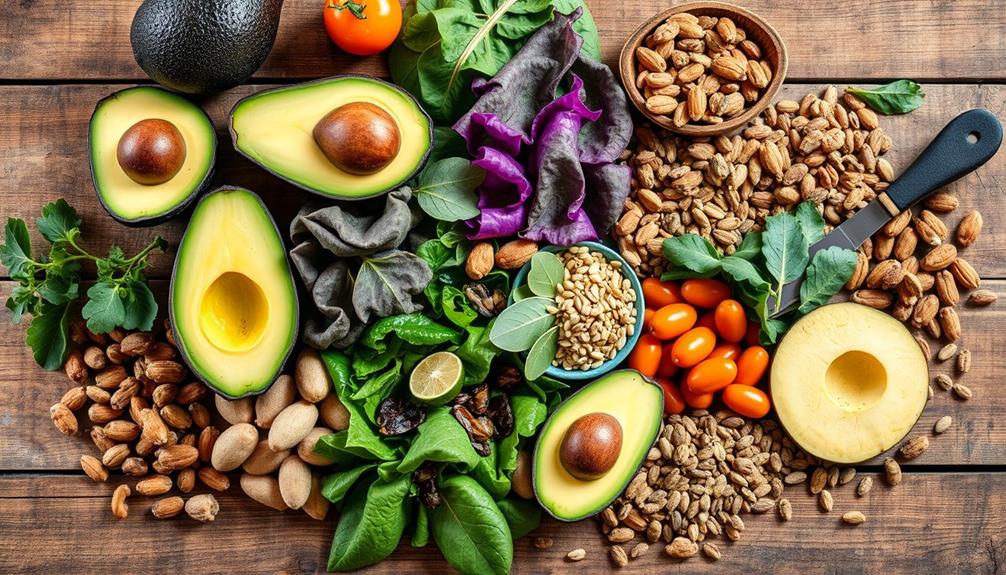To successfully follow a ketogenic diet, you'll need to limit your daily carb intake to between 20 and 50 grams of net carbs. Staying within this range helps your body shift into ketosis, where it burns fat for energy instead of glucose. It's crucial to calculate net carbs by subtracting fiber and sugar alcohols from total carbs. Be mindful of hidden carbs in processed foods, as these can quickly push you over your limit. By understanding these basics, you'll set yourself up for success. Discovering more tips for tracking and maintaining ketosis can help you on this journey.
Key Takeaways
- To maintain ketosis, daily net carb intake should be kept below 50 grams, ideally between 20 to 50 grams.
- Net carbs are calculated by subtracting fiber and half of sugar alcohols from total carbohydrates.
- Individual factors such as weight and energy demands can influence the ideal carb target on a ketogenic diet.
- Hidden carbs in processed foods can disrupt ketosis; tracking carbohydrate intake is essential.
- Consistent monitoring of ketone levels helps ensure adherence to the ketogenic diet and effective fat burning.
Understanding the Ketogenic Diet

When you commence the ketogenic diet, you'll quickly discover that it emphasizes drastically reducing your carbohydrate intake to less than 50 grams of net carbs per day. This carbohydrate restriction is essential for shifting your body's energy source from glucose to fat, which is the primary goal of the ketogenic diet.
Incorporating regular physical activity can further enhance your results on this diet, as exercise plays a significant role in optimizing health and promoting fat burning effective strategies for weight loss. Achieving ketosis, the metabolic state where your body burns fat for fuel, typically occurs after maintaining this low-carb intake for about 3-4 days.
To effectively follow the ketogenic diet, you should focus on a macronutrient ratio of approximately 70-80% fat, 5-10% carbohydrates, and 10-20% protein.
It's vital to remember that net carbs are calculated by subtracting fiber and sugar alcohols from total carbohydrates, as only these net carbs impact ketosis.
Individual factors, such as your weight and fitness level, can influence your ideal carbohydrate target within this framework.
Daily Carb Recommendations
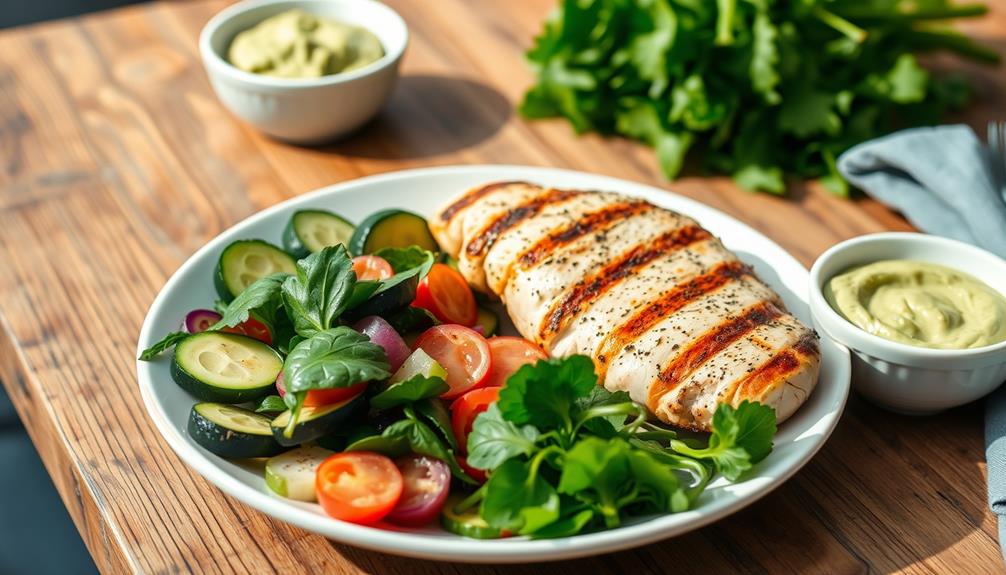
When following a ketogenic diet, it's crucial to keep your daily carb intake below 50 grams to maintain ketosis. By prioritizing a high-fat, low-carb approach, you can effectively manage your weight and energy levels.
You should focus on net carbs, ideally keeping them between 20 to 50 grams by subtracting fiber and sugar alcohols. For more information on common financial terms, remember, your specific carb limit may vary based on your weight, fitness level, and health goals, so it's important to tailor your approach.
Recommended Carb Limits
To effectively maintain ketosis on a ketogenic diet, it's generally recommended that you limit your daily carbohydrate intake to less than 50 grams. However, individual needs can vary. For some, especially those with higher energy demands, carb limits can range from 20 to 100 grams per day. The key is to find what works best for you.
Additionally, monitoring your carbohydrate intake is important as hidden carbs can be found in various foods, including processed options that may not be immediately obvious. For example, some juices, like celery juice, can contain sugars that may affect your carb limits.
When focusing on your carb limits, remember that net carbs are vital. Net carbs are calculated by subtracting fiber and sugar alcohols from total carbs. Aiming for 20-50 grams of net carbs daily can help you stay in ketosis and support weight loss.
It's essential to consistently track your carbohydrate intake to avoid hidden carbs found in processed foods, which can quickly add up. While the general guideline is useful, your individual tolerance to carbs can influence your success on a low carb diet.
Some people may thrive with slightly higher carb limits while still achieving their weight loss goals and enjoying health benefits. By monitoring your intake and adjusting as needed, you can find the right balance to make your ketogenic diet a sustainable lifestyle.
Understanding Net Carbs
Understanding net carbs is essential for successfully guiding your daily carb recommendations on the ketogenic diet. To maintain ketosis, you'll want to keep your daily intake of net carbs between 20 to 50 grams.
But what're net carbs? They're calculated by subtracting fiber and half of the sugar alcohols from the total carbohydrates in a food item. For instance, if you have a food with 20 grams of total carbs, 8 grams of fiber, and 5 grams of sugar alcohols, your net carbs would be calculated as follows: 20 – 8 – 2.5 = 7 grams of net carbs.
It's also important to take into account the role of hydration and nutrient intake while following a low-carb diet, as these can greatly influence your overall well-being and energy levels. Incorporating foods beneficial for managing gout symptoms can also help you maintain a balanced approach to nutrition.
Tracking net carbs is vital for sticking to the ketogenic diet, as eating too many can hinder your ability to enter or maintain ketosis.
Focus on incorporating low-carb foods into your meals, such as non-starchy vegetables and healthy fats, to help you stay within your daily limits. By understanding and monitoring your net carbs, you empower yourself to make informed choices that will keep your ketogenic journey on track.
What Are Net Carbs?

Net carbs refer to the carbohydrates that actually affect your blood sugar levels, calculated by subtracting dietary fiber and half of the sugar alcohols from total carbs.
Understanding how to calculate net carbs is vital for sticking to your keto diet and reaping its benefits.
For instance, incorporating essential oils like eucalyptus oil can support respiratory health, which is beneficial when following a diet change.
Definition of Net Carbs
When following a ketogenic diet, it's vital to grasp the concept of net carbs, as this measurement directly impacts your ability to maintain ketosis. Net carbs are calculated by subtracting fiber and half of the sugar alcohols from the total carbohydrates in a food item. This gives you a clearer picture of the carbs that actually affect your blood sugar levels.
Being aware of how different foods contribute to your overall carb intake is essential, as some may have hidden sugars that can be misleading, much like understanding toilet flushing efficiency to manage household costs.
On a keto diet, you typically want to limit your net carb intake to 20-50 grams per day. This restriction helps your body enter and stay in ketosis, where it burns fat for fuel instead of carbohydrates. Foods high in fiber, like non-starchy vegetables, can be great choices since fiber doesn't contribute to net carbs, promoting better digestive health.
Understanding net carbs is essential, especially since hidden carbs in processed foods can easily push you over your daily limit and disrupt your ketosis. By focusing on net carbs rather than total carbohydrates, you can prioritize foods that align with your weight loss and health goals while keeping your blood sugar levels stable.
This knowledge is a key element of successfully maneuvering your ketogenic diet.
Calculating Net Carbs
To effectively manage your carb intake on a ketogenic diet, it's vital to know how to calculate net carbs accurately. Net carbs are derived by subtracting dietary fiber and half of sugar alcohols from total carbohydrates. This calculation helps you identify the carbs that affect your blood sugar levels.
For instance, if a food item has 20 grams of total carbohydrates, 8 grams of fiber, and 5 grams of sugar alcohols, you'd find the net carbs like this: 20 – 8 – 2.5, resulting in 7 grams of net carbs.
In addition to managing your carb intake, diversifying your diet with healthy fats can also play a role in overall wellness, similar to how IRA rollover options can protect your retirement portfolio.
On a keto diet, sticking to a net carb limit of 20 to 50 grams daily is essential for achieving and maintaining ketosis. By accurately calculating net carbs, you can avoid consuming too many carbs that could hinder your progress.
Focusing on low-carb foods, like non-starchy vegetables and healthy fats, will help you stay within your limits while still meeting your nutritional needs. Remember, the goal is to keep your body in ketosis, so always check those labels and do the math!
Importance in Keto
Understanding net carbs is fundamental to succeeding on the ketogenic diet. Net carbs are calculated by subtracting fiber and half of sugar alcohols from your total carbohydrate intake. This figure reflects the carbohydrates your body actually absorbs, which is essential for maintaining ketosis.
For most people on a keto diet, limiting net carbs per day to 20-50 grams is necessary for effective fat burning instead of glucose. Incorporating high-fiber foods can be advantageous, as they not only help manage net carb intake but also promote overall health, similar to how different brewing methods affect caffeine levels in coffee.
Accurate tracking of your net carb count is critical. If you exceed this limit, you risk disrupting ketosis, which can undermine your weight loss goals. Focus on foods high in fiber, like non-starchy vegetables, as they not only keep your net carb count low but also contribute to overall health.
It's important to understand the difference between total carbs and net carbs when planning your meals. This distinction guarantees you're meeting nutritional needs while adhering to a low-carb diet.
Calculating Your Carb Intake
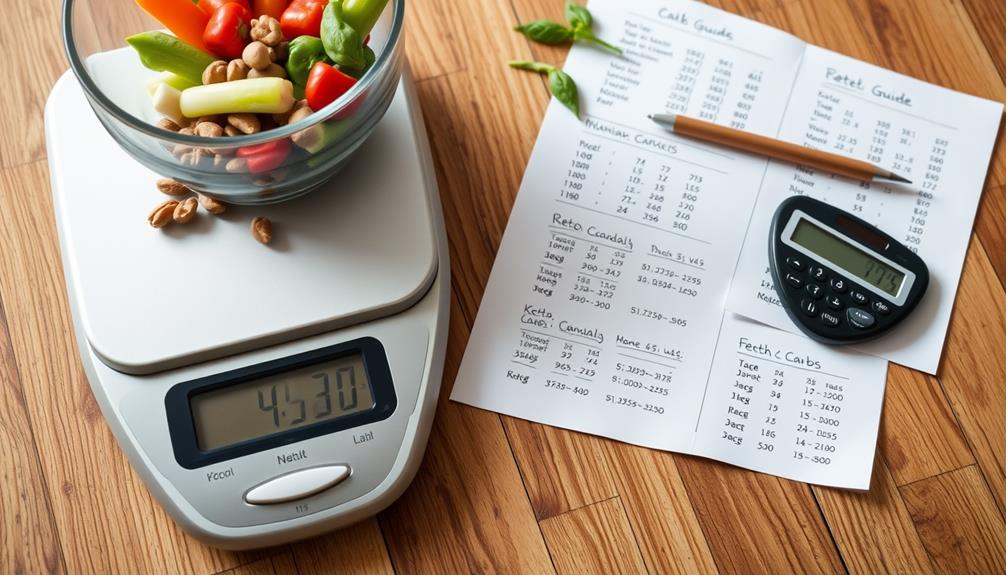
Accurately calculating your carb intake is essential if you want to stay in ketosis on the ketogenic diet. To effectively manage your daily intake, focus on net carbs, which are the total carbohydrates minus dietary fiber and half of sugar alcohols. Keeping your net carbs between 20 to 50 grams is vital for maintaining ketosis.
Additionally, understanding content relevance and authority in your meal choices can help you make informed decisions about the foods you consume.
To help you calculate your carb intake, follow these steps:
- Check Total Carbohydrates: Look at the nutrition label for the total carbohydrates in a food item.
- Subtract Dietary Fiber: Deduct the grams of dietary fiber from the total carbohydrates, as they don't impact your blood sugar.
- Account for Sugar Alcohols: If applicable, subtract half of the sugar alcohols to get your net carbs.
For example, if a food has 20 grams of total carbohydrates, 8 grams of fiber, and 5 grams of sugar alcohols, the net carbs would be 7 grams (20 – 8 – 2.5).
Foods to Include on Keto
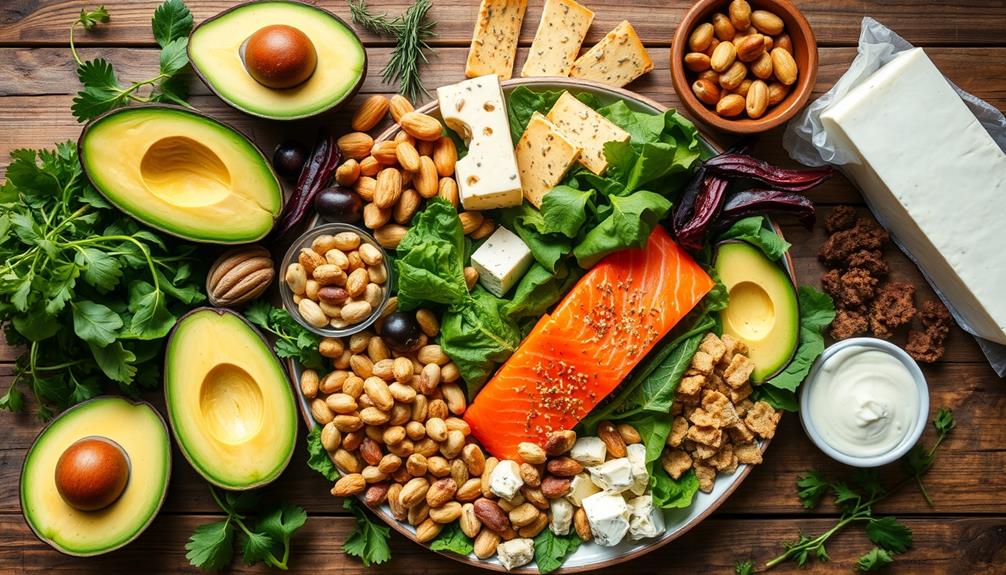
When you're following a keto diet, it's vital to focus on foods that support your low-carb lifestyle. Incorporate healthy fats like avocados and olive oil, which are essential for maintaining energy levels while on a low-carb regimen.
Adding essential beach toys can also provide a fun way to enjoy outdoor activities that complement an active lifestyle.
Don't forget to include low-carb vegetables such as spinach and kale, along with protein-rich options like fatty fish and eggs to balance your meals effectively.
Healthy Fats Sources
Including healthy fat sources in your ketogenic diet is essential for reaching and maintaining ketosis. Healthy fats not only provide energy but also support your overall health. Here are some top sources to include:
- Olive Oil: Packed with about 14 grams of fat per tablespoon, olive oil is rich in heart-healthy omega-9 fatty acids. It's perfect for salad dressings or cooking at low temperatures.
- Almonds: These nuts are a satisfying snack, offering approximately 14 grams of fat and only 2.6 grams of net carbs per ounce. They're a great way to incorporate healthy fats into your day.
- Coconut Oil: With around 14 grams of saturated fat per tablespoon, coconut oil can help boost ketone production, providing you with sustained energy throughout the day.
Don't forget about avocados and fatty fish like salmon, which are also excellent healthy fats sources.
They're rich in monounsaturated fats and omega-3 fats, contributing to your ketogenic diet's success. Incorporating these foods will help you stay on track and enjoy your keto journey!
Low-Carb Vegetables Options
Steering through a ketogenic diet means you can still enjoy a variety of delicious low-carb vegetables that fit perfectly into your meal plan. Non-starchy vegetables are your best friends here, as they're low in net carbs. For example, spinach has just 0.4 g net carbs per 100 g, making it a fantastic base for salads or smoothies.
Cruciferous vegetables like broccoli and cauliflower are also excellent choices, providing fiber and nutrients without pushing you over your carb limits. Broccoli contains 3.7 g net carbs, while cauliflower offers 3.2 g net carbs per 100 g.
Zucchini, with only 2.1 g net carbs, can be spiralized into zoodles, adding versatility to your meals.
Don't forget about bell peppers, especially the red ones, which bring flavor and vibrant color to your dishes with just 2.9 g net carbs per 100 g.
Finally, mushrooms, such as white button mushrooms, clock in at about 3.3 g net carbs, making them great additions to salads or stir-fries.
Incorporating these low-carb vegetables into your ketogenic diet will help you stay on track while enjoying a variety of tasty meals.
Protein-Rich Foods
A ketogenic diet thrives on protein-rich foods that not only support muscle maintenance but also fit seamlessly into your low-carb lifestyle.
These foods are essential as they provide the necessary protein while keeping your carb intake low. Here are some excellent options to include in your meals:
- Fatty Cuts of Meat: Ribeye steak and pork belly are perfect choices, offering both protein and healthy fats while keeping net carbs minimal.
- Seafood: Fatty fish like salmon and mackerel are packed with omega-3 fatty acids and high in protein, with very few carbs—ideal for heart health.
- Eggs: A staple in the ketogenic diet, one large egg contains about 6 grams of protein and less than 1 gram of carbs, making it an economical choice.
Additionally, dairy products like cheese and Greek yogurt provide high protein content along with healthy fats, while nuts and seeds, such as almonds and chia seeds, offer plant-based protein sources with beneficial fats.
Incorporating these protein-rich foods into your high fat diet will help you stay on track with your keto goals!
Foods to Avoid on Keto

When starting on a keto diet, it's crucial to steer clear of foods that can sabotage your efforts to maintain ketosis. High carbohydrate foods, like grains, will quickly push you over your daily limit of 20-50 grams of net carbs. This means saying goodbye to bread, pasta, and rice.
Starchy vegetables such as potatoes, sweet potatoes, and corn are also high in carbs, so it's best to eliminate or minimize them from your meals.
Most fruits, especially high-carb options like bananas and grapes, should be avoided due to their significant sugar content.
Don't forget about sugary drinks! Regular soda and sweetened fruit juices contain excessive carbohydrates that can derail your keto progress.
Even seemingly innocent processed foods can be culprits, as they often hide sugars and high-carb ingredients. Always read labels carefully to avoid unexpected carb intake.
Common Mistakes to Avoid
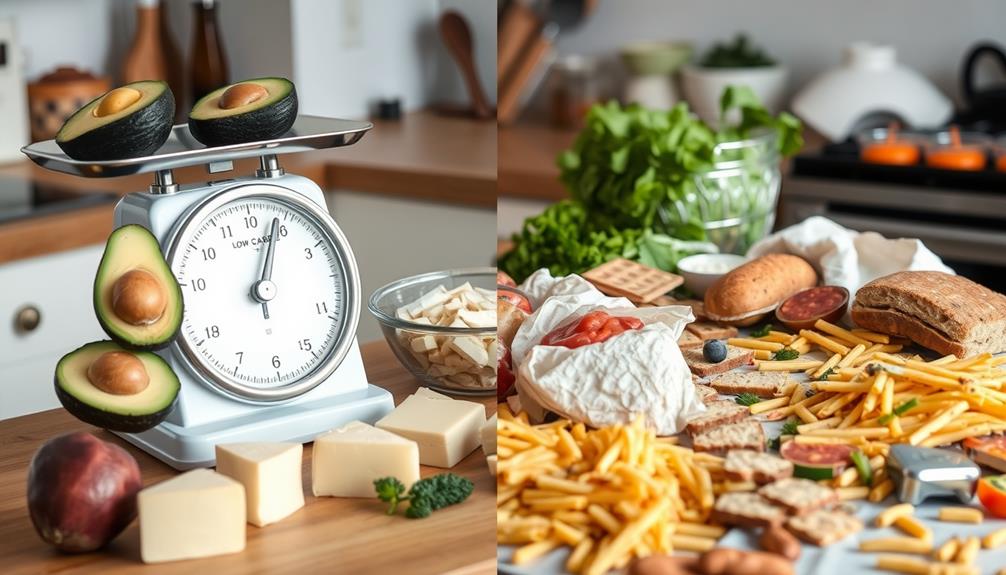
Many people find that even with the right foods, they still struggle to maintain ketosis. Here are some common mistakes to avoid on your ketogenic diet:
- Underestimating Hidden Carbs: Processed foods can contain hidden carbs that sneak up on you. Always check labels and stay within the recommended 20-50 grams of net carbs.
- Overconsuming Protein: It's easy to think more protein is better, but exceeding 0.7-0.9 grams per pound of body weight can lead to gluconeogenesis. This process converts excess protein into glucose, disrupting your ketosis.
- Neglecting Hydration and Electrolytes: As your carb intake decreases, your body excretes more water and sodium, increasing your risk of "keto flu." Staying hydrated and replenishing electrolytes is vital for maintaining energy and well-being.
Additionally, relying too heavily on processed keto foods can lead to an imbalanced diet.
Prioritize whole foods to guarantee you're getting a variety of nutrients.
Monitoring Ketosis Levels
Monitoring your ketosis levels is vital for guaranteeing you stay on track with your ketogenic diet. To maintain ketosis, aim to keep your daily net carbs below 50 grams, although some people may thrive on just 20 grams. Regularly monitoring ketone levels can help you gauge your progress. You can use urine test strips, breath analyzers, or blood ketone meters, with blood tests offering the most accurate results.
Be mindful of hidden carbohydrates in processed foods, as they can sneak into your daily intake and disrupt your ketosis. Tracking dietary intake meticulously is essential to confirm you remain within your carb limit. Familiarize yourself with the common signs of ketosis, such as increased thirst, frequent urination, and a distinct fruity or acetone-like breath odor.
In addition to monitoring ketone levels, pay attention to your energy levels and mental clarity. These factors can provide valuable insights into whether you're successfully maintaining ketosis. By keeping a close eye on these elements, you can fine-tune your approach and guarantee you're getting the most out of your ketogenic diet.
Health Benefits of Keto

The ketogenic diet offers a range of health benefits that go beyond just weight loss. By greatly reducing your intake of net carbs, you can experience improvements in various aspects of your health.
Here are three key benefits you might enjoy:
- Weight Loss: Many people experience substantial weight loss on the ketogenic diet, with some studies showing a mean weight loss of 13% among obese adults in just 8 weeks. This is partly due to reduced hunger levels, making it easier for you to stick to your goals.
- Improved Insulin Levels: The ketogenic diet can enhance insulin sensitivity, which is particularly beneficial for managing blood sugar levels. This can be a game changer for those dealing with type 2 diabetes.
- Better Cardiovascular Health: Following a ketogenic diet can lead to improved blood pressure and lipid profiles, with noticeable reductions in cholesterol and triglyceride levels.
Tips for Long-Term Success

Achieving long-term success on the ketogenic diet hinges on understanding and managing your carbohydrate intake. Aim for a net carb intake of 20-50 grams per day to maintain ketosis effectively. To avoid hidden carbs in processed foods, consistently track your daily carbohydrate intake using a food diary or nutrition app.
Incorporate a variety of low-carb foods, such as non-starchy vegetables, healthy fats, and high-quality proteins. This guarantees you get the nutrients you need while adhering to the ketogenic diet. Staying hydrated is vital, especially during the adjustment period. Consider supplementing with electrolytes to help mitigate symptoms of the "keto flu" and maintain your energy levels.
Regularly assess your progress by monitoring weight, body measurements, and ketone levels. This will help you adapt your dietary approach as needed for continued success.
If you notice any plateaus, don't hesitate to tweak your carb intake or experiment with different low-carb foods to find what works best for you. Remember, consistency is key, so establish a routine that supports your goals and keeps you motivated on your keto journey.
Frequently Asked Questions
How Many Carbs Can I Eat and Stay in Ketosis?
To stay in ketosis, you should limit your net carb intake to about 20 to 50 grams daily. Monitor your ketone levels to confirm you're within this range for ideal fat-burning results.
Can You Lose Weight on 50 Carbs a Day?
Can you really shed pounds eating just 50 carbs a day? Absolutely! This low intake helps your body burn fat for energy, often leading to significant weight loss and reduced hunger, making it easier to stick with.
Is 30 Carbs a Day Still Keto?
Yes, 30 carbs a day still keeps you in ketosis. You'll enjoy flexibility in your food choices while benefiting from weight loss and increased energy, as long as you track your intake carefully.
What Do 50 Grams of Carbs Look Like on Keto?
You've got to watch your carbs like a hawk. Fifty grams might look like a medium sweet potato and a couple cups of broccoli, but it adds up quickly—especially if you sneak in some fruit!
Conclusion
So, you've mastered the art of avoiding carbs like they're the last cookie at a party. Remember, hitting that magical 20-50 grams of net carbs daily isn't just a suggestion—it's your new mantra! Embrace the butter, cheese, and avocado like they're your new best friends. Just steer clear of the bread aisle, unless you fancy a staring contest with a loaf. With a sprinkle of discipline and a dash of humor, you'll be thriving in ketosis in no time!


